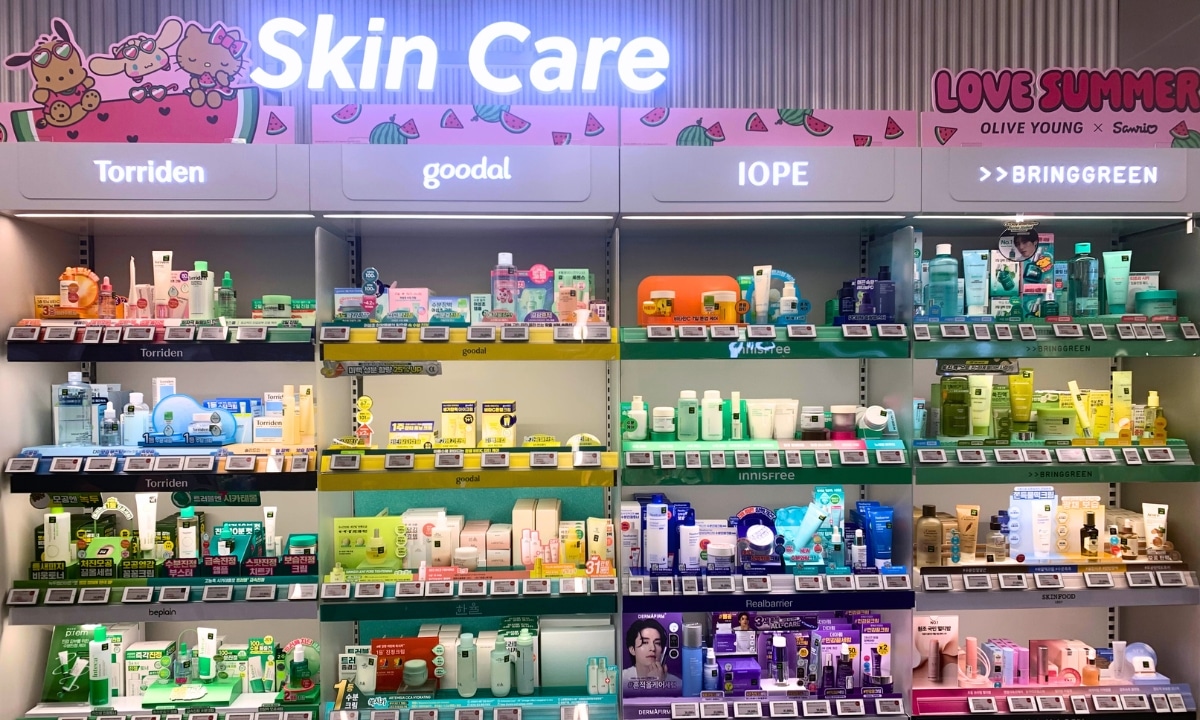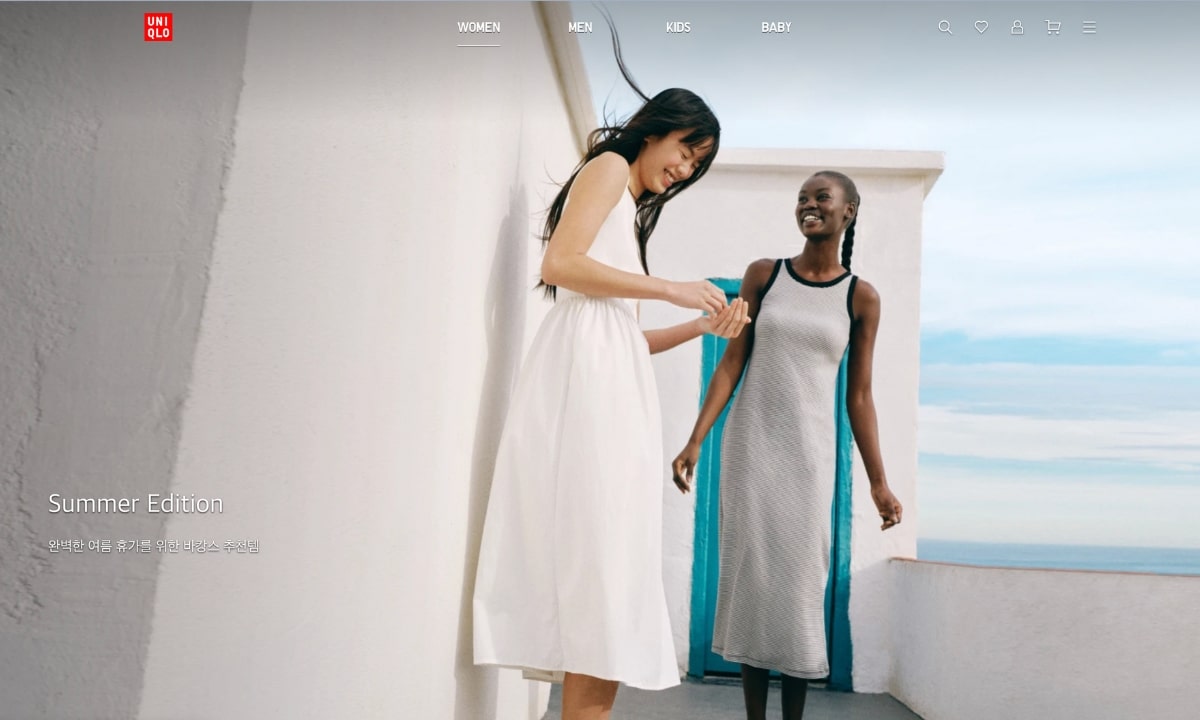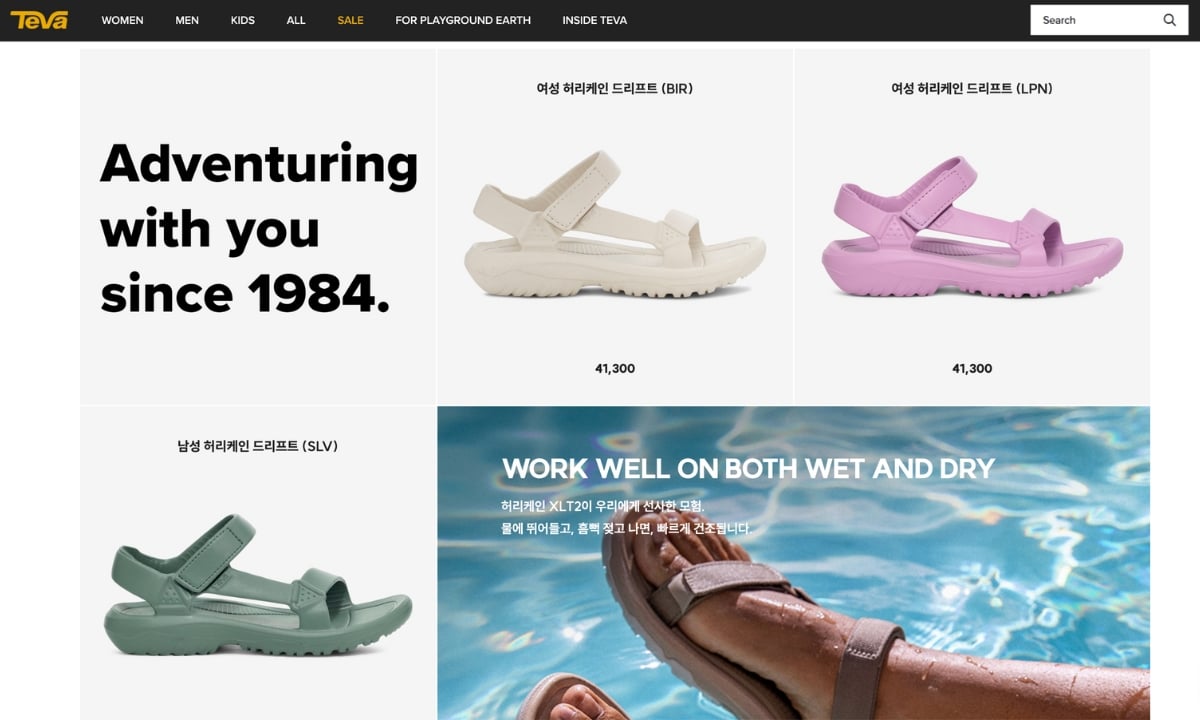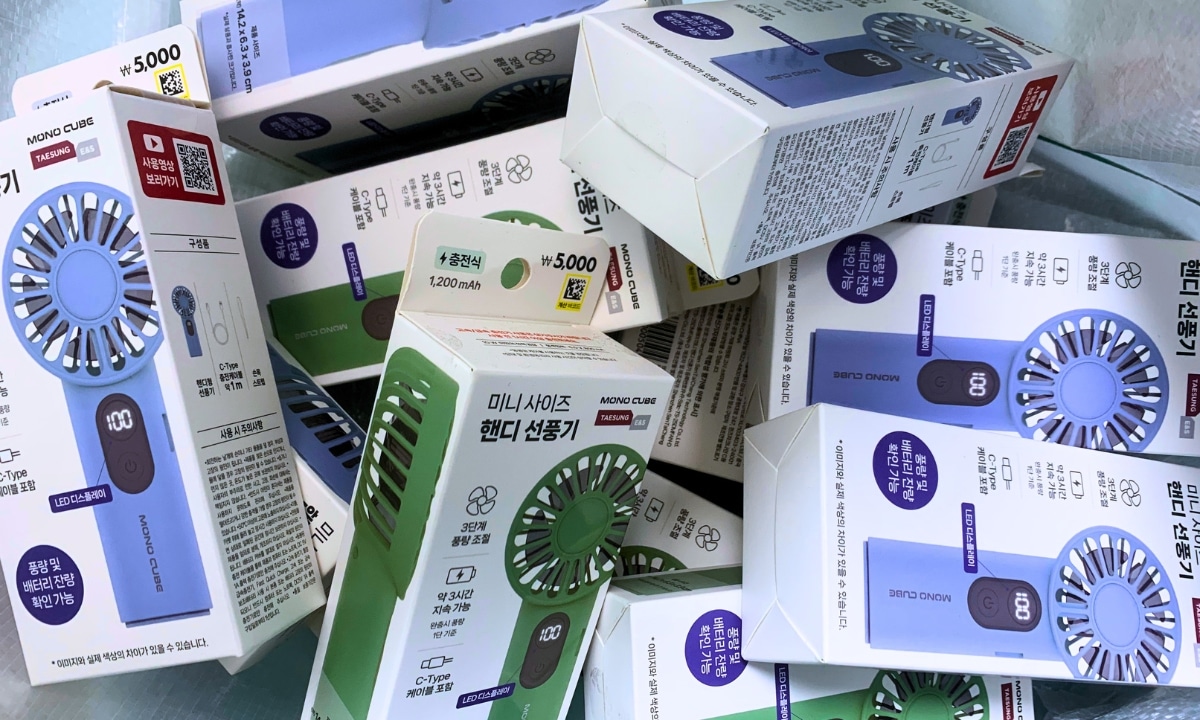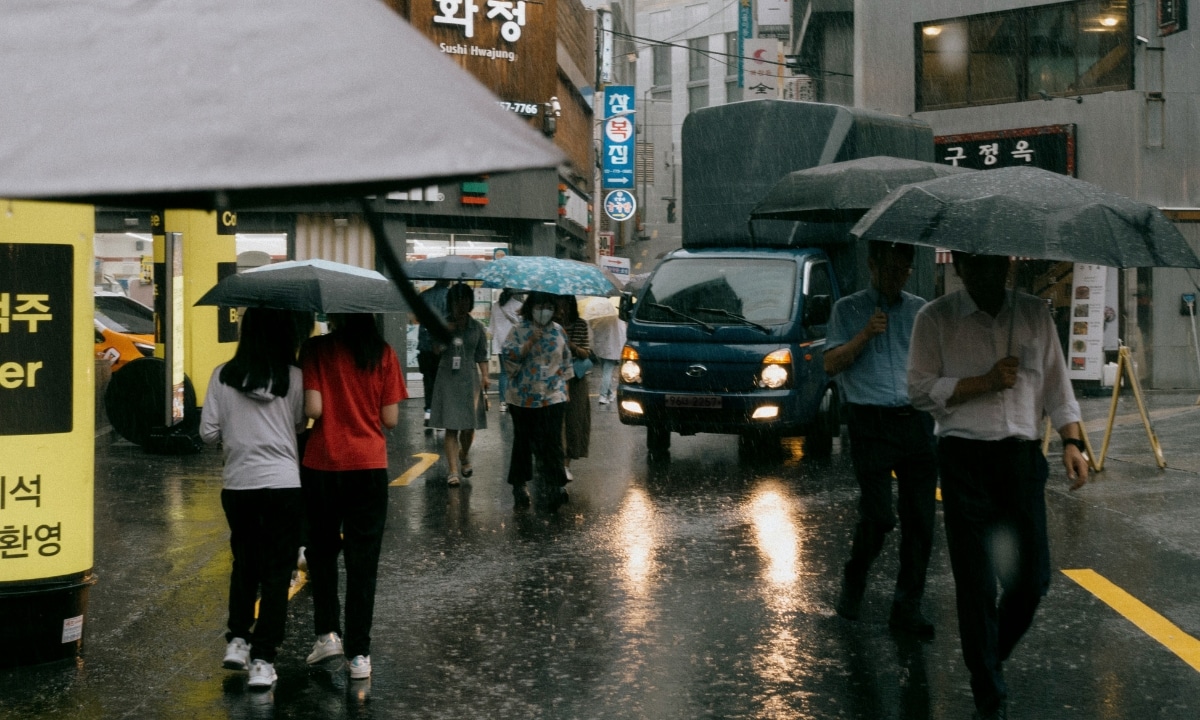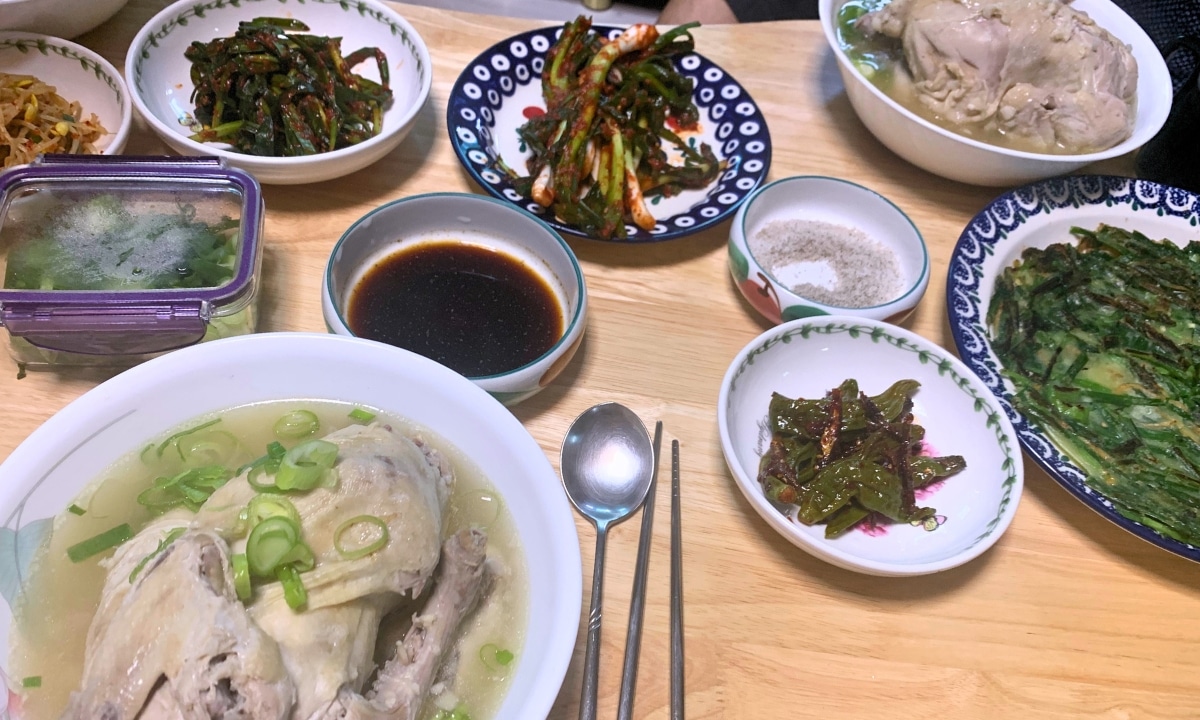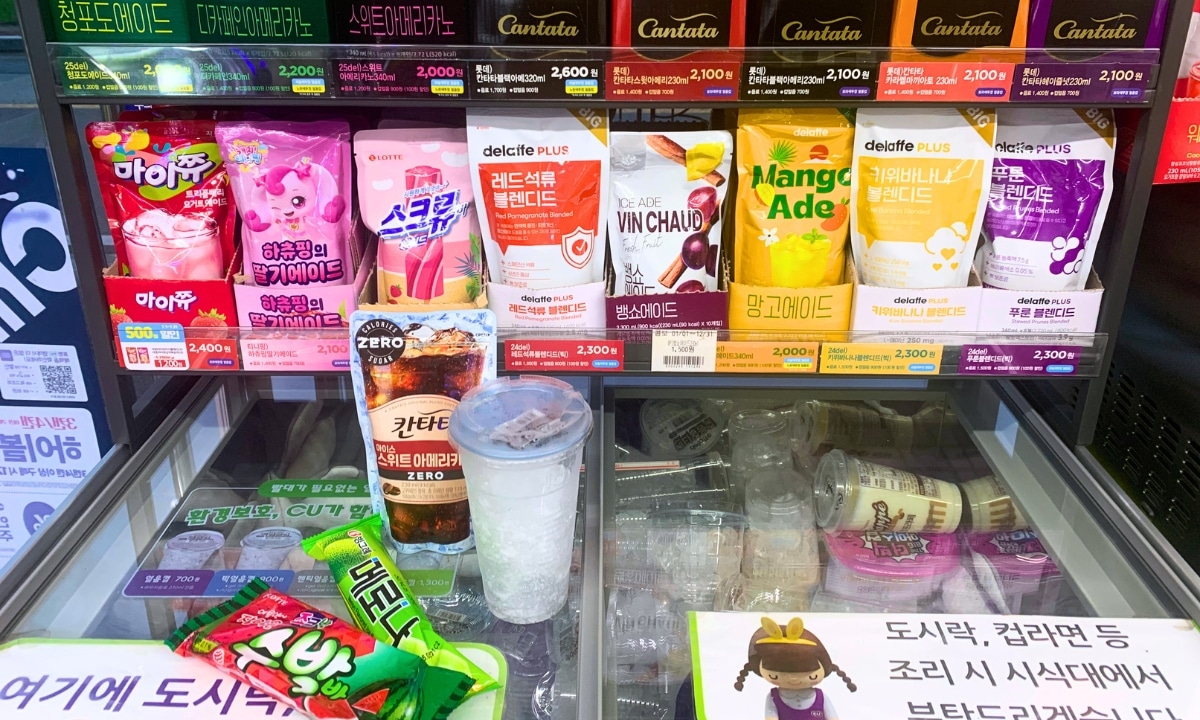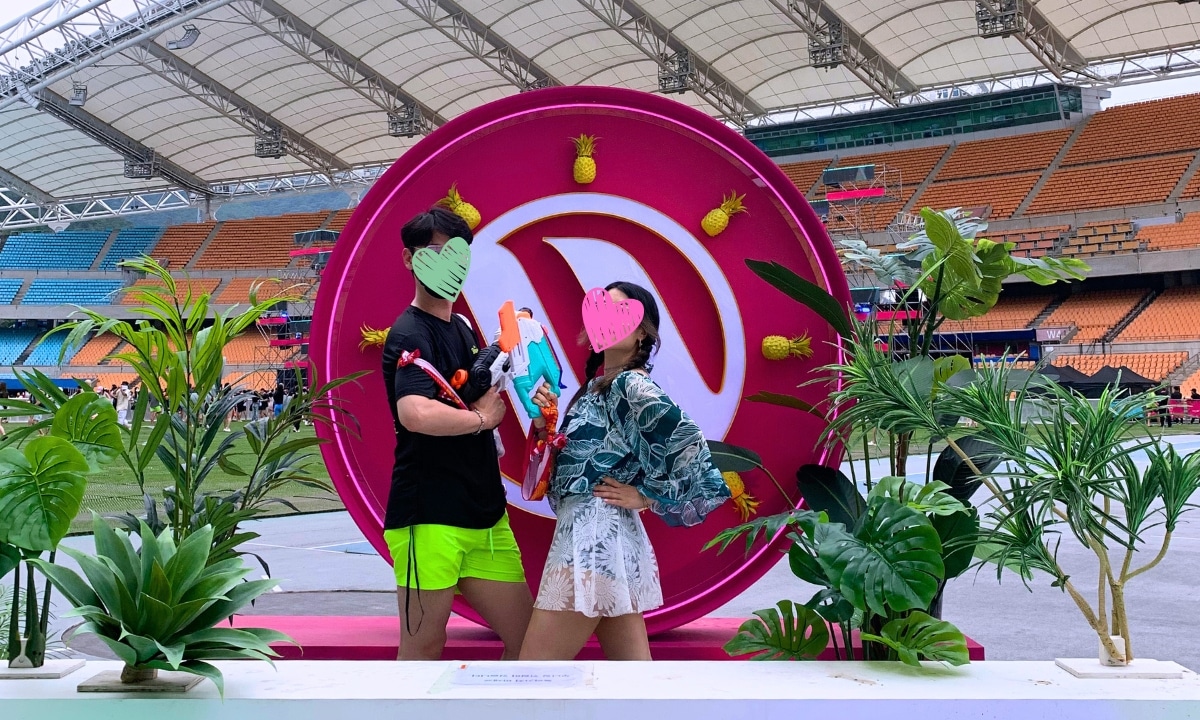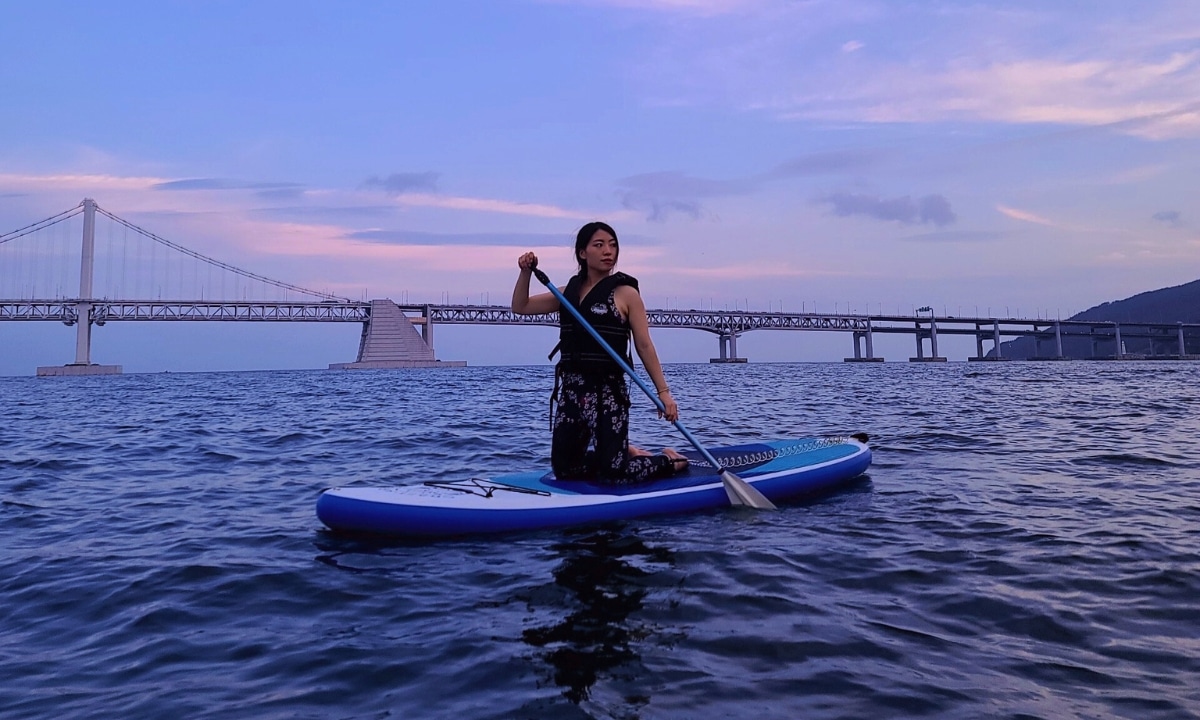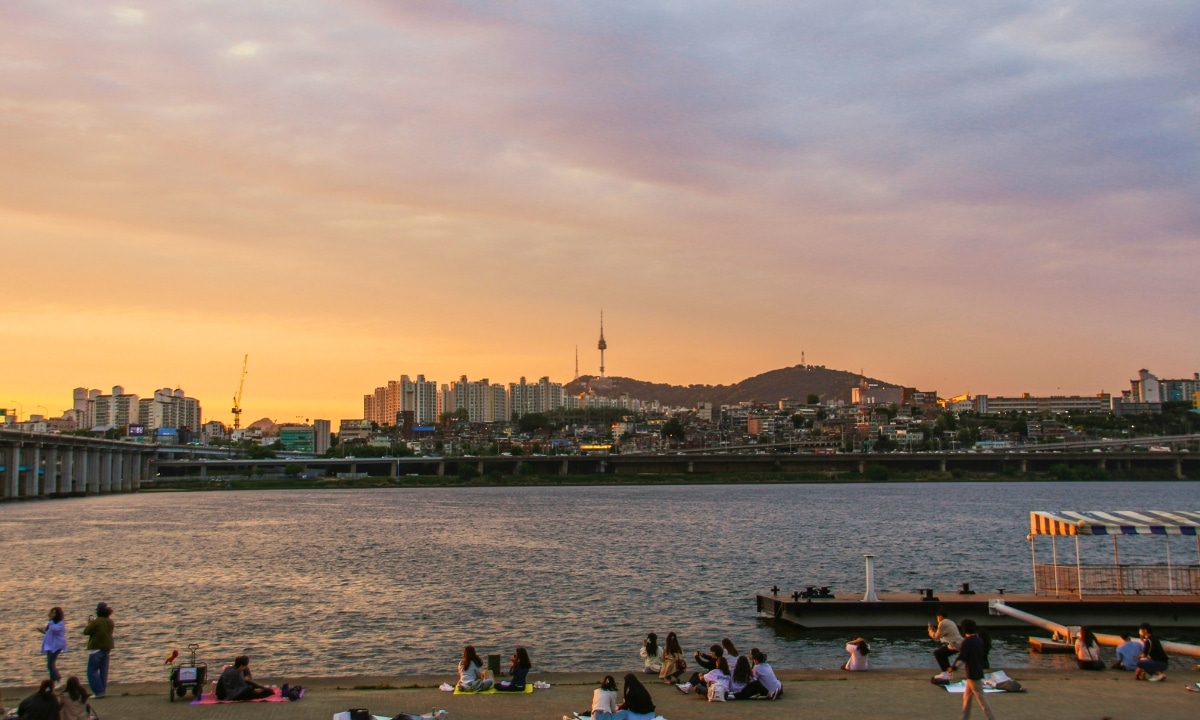Here Comes the Sun (or the Rain)
Stepping outside my apartment, the heat immediately hits you in the face. I barely walk three feet before I find myself dripping sweat and daydreaming about my next shower. The last one I took was just 30 minutes ago.
Later in the day, I go out to meet a friend for dinner. It starts as a few dribbles, then whoooosh! Even the sky is weeping, and a terrential downpour ensues. Monsoon season is here, and while it’s my summer vacation I don’t get a break from the elements. Summer is in full swing.
While it might sound miserable (and without exaggeration, sometimes it really is), after living in Korea for a few years I have learned to adapt to Korean summers. All around me, people are carrying on with life as usual, going about their days with a full face of makeup, and bali bali (AKA “quickly quickly” in Korean) schedules. There are even a few lucky ones who enter the cool air-conditioned subway without a lick of sweat.
For first-time visitors to Korea, it’s important to be prepared if you plan on traveling to Korea in the summer. So, here’s a practical guide of tips, local hacks, and trending products that will help you survive (and thrive) in Korean summers.
Summer Skin & Sun Protection
Sunscreen Essentials
This goes without saying, but sunscreen is essential for any skincare routine, especially during the summer months when UV indexes are at their peak. In Korea, people typically reapply sunscreen (called “suncream” locally) throughout the day. Every year, new and improved products hit the market, ranging from makeup cushions and creams to sprays and stick-type SPFs that can be applied over makeup.
Currently in Korea, trending sunscreen types include:
- Stick sunscreens – Great for reapplication and applying over makeup
- Essence and serum-textured sunscreens – Combining skincare and SPF in one
- Vegan and reef-safe options – Environmentally conscious choices
- Cooling sunscreens – Offering a menthol or ice-like effect for hot days
- Multi-use SPFs – Combining makeup essentials like tone-up cream and primer
- Minimal white cast – Most Koreans prefer chemical formulas for a natural finish
When choosing the best sunscreen, it’s important to find one that suits your skin type and lifestyle. It may take some trial and error, but here are a few brands that are widely loved across various skin types:
- Beauty of Joseon – Relief Sun: Rice + Probiotics SPF50+ PA++++
- Round Lab – Birch Juice Moisturizing Sun Cream SPF50+ PA++++
- Isntree – Hyaluronic Acid Watery Sun Gel SPF50+ PA++++
- Skin1004 – Madagascar Centella Air-Fit Suncream Plus SPF50+ PA++++
- Abib – Quick Sunstick Protection Bar SPF50+ PA++++
- Torriden – Dive-In Mild Sun Cream SPF50+ PA++++
Cooling Patches, Wipes, and Sweat Towels
If you need to freshen up and cool off throughout the day, look for cooling patches and facial mists. These items can easily be stashed in office desks and bags, and are available at convenience stores and Korean beauty suppliers like Olive Young.
Another great trick is keeping sheet masks in the fridge, and adding them into your beauty care routine after a hot day. And if you really need it, bring around a small handkerchief or small towel to catch the sweat. Just don’t forget to reapply sunscreen.
Cooling Feminine Care
While not for everyone, this summer, out of curiosity I decided to try cooling feminine pads. It took some getting used to, but it’s a discreet and useful way to stay cool in high humidity. Items like this can be picked up from convenience stores, as well.
Dressing for Korean Summers
Dress Modestly, but Comfortably
Compared to many Western countries, Koreans tend to dress more conservatively and modestly, even during the hottest times of the year. At first, this might be hard to understand, but if you want to adapt to local norms, consider wearing clothing that is both lightweight and breathable. Opt for fabrics like linen or tech materials such as Nike’s Dri-FIT or Uniqlo’s AIRism. Quick-drying and sweat-wicking fabrics are excellent choices for both rain and heat and are far more comfortable than jeans or thick cotton.
Modest dress is especially noticeable at historical sites, temples, and in regions outside major cities like Seoul. That said, sleeveless tops are becoming increasingly popular among younger women, though typically without showing cleavage and often designed with high necklines for a more covered look.
Prepare for Sudden Rain with Light Layers
One of the memories that will forever stick with me is running through the streets of Seoul during peak rainy season. It was raining so hard the roads were nearly flooded, and by the time I reached the train station, I was drenched from head to toe. After multiple experiences like this, I’ve learned that Korea’s rainy season is unpredictable and not something to take lightly.
Always carry an umbrella with you during the summer, and consider bringing a foldable raincoat or poncho, along with a change of socks or a small towel in your bag. You can also purchase waterproof bags and shoe covers at convenience stores. Most shops and restaurants provide plastic umbrella sleeves, or have machines that spin-dry your umbrella before you enter.
Proper Footwear is a Must
One essential I rely on during Korean summers is water-resistant or waterproof sandals or shoes. Platform sandals and jelly shoes are back in style and help elevate your feet off the ground, keeping them cleaner as rainwater mixes with street dust and debris. Just make sure your shoes have good grip and traction to prevent slipping on wet surfaces.
Having once spent hours drying my clothes and shoes with a hotel hair dryer before a 14-hour flight, I can say with full confidence: the right gear and clothing will make you much happier during monsoon season.
Summer Accessories You’ll See Everywhere
Umbrellas: Not Just for Rain
In Korea, umbrellas are cheap and easily accessible at convenience stores, Daiso (Korea’s version of a dollar store), and popular chains like Olive Young and ArtBox. Clear umbrellas are especially trendy right now, not only are they stylish, but they also make it easier to navigate crowded sidewalks.
Beyond rain protection, you’ll also find parasols and UV-blocking umbrellas designed to shield you from harmful rays. It’s one of the many reasons you’ll see Koreans using umbrellas even on bright, sunny days.
One of my favorite types of umbrellas are the large ones installed over pedestrian crossings. These provide perfect shade and protection from both sun and rain, and are commonly found throughout cities and towns.
Small But Mighty Portable Fans
At Daiso and convenience stores, you can also find mini rechargeable fans—either handheld or designed to hang around your neck. These are incredibly helpful on scorching days when you’re commuting or spending time outside.
They also come in a wide variety of cute styles, colors, and designs, making it easy to pick one that matches your personality or outfit while you’re traveling in Korea.
Heat Wave and Rainy Season Survival Tips
Avoid Peak Sun Hours
The best way to stay cool in Korea is to avoid peak sun hours, typically between 11AM and 4PM from June through August. Of course, you probably won’t want to stay indoors the entire time! Luckily, there are plenty of great indoor escapes throughout Korea.
Consider visiting large department stores like Hyundai or Shinsegae, or explore underground shopping centers near COEX or the Express Bus Terminal in Gangnam. Other great options include cafés, cinemas, museums, traditional markets, and covered sports stadiums, all perfect for escaping the harshest hours of the sun.
It’s helpful to plan out your day in advance, grouping activities or appointments by location to minimize outdoor travel during peak heat. To make this easier, use Korean navigation apps like KakaoMap or Naver Map. These apps can help you find shaded or underground routes and bus stops with A/C shelters.
Honestly, one of the best parts about being in Korea’s bigger cities is that nearly every subway car is clean, modern, and air-conditioned—a rare luxury if you’re coming from the U.S.
Keep Safe: Use Korean Weather and Air Quality Apps
Although people generally carry on with their day even during the rainy season, it’s important to pay attention to government alert messages about flash flood warnings on heavy rain days (these can be translated via apps if needed).
For accurate and localized forecasts, avoid Google or non-Korean weather apps. I recommend using Weather Sky, a reliable Korean app that gives detailed forecasts and even offers clothing recommendations based on the temperature and conditions.
For air quality updates, download apps like:
- MiseMise (미세미세)
- AirVisual
- KakaoWeather
These help track fine dust (미세먼지) and yellow dust, which can be especially problematic on humid or hazy days. On poor air quality days, you’ll want to wear a mask or avoid being outdoors too long. Luckily, convenience stores in Korea often sell lightweight, breathable face masks designed specifically for summer.
Summer Home Care
If you live in Korea or plan to stay long-term, it’s important to ventilate your apartment regularly to prevent mold buildup. You may also want to pick up charcoal packs or a small, affordable dehumidifier from Daiso.
Something my husband bought a few years ago (and we now absolutely love) is a cooling mat that sits right on top of our bed. The fabric stays cool to the touch and helps us sleep comfortably, even on the hottest summer nights.
Summer Meals to Help Cool You Off
Meals for “Boknal Days”
Boknal Days (삼복날) are known as the hottest days of summer in Korea. On these days, locals traditionally eat hot foods like samgyetang (ginseng chicken soup) to restore energy, following the principle of iyeol chiyeol (이열치열), which means “fight heat with heat.”
However, there are also several refreshing traditional Korean dishes that are perfect for summer:
- Naengmyeon – Cold buckwheat noodles in a tangy broth
- Kongguksu – Cold soy milk noodles: creamy and nutty
- Mul-hwachae – Chilled fruit punch with floating slices of seasonal fruit
- Pat-bingsu – Shaved ice topped with red beans, fruit, and condensed milk
Limited-Time Menu Items
Every season in Korea brings special, limited-time menu items, and summer is no exception. One of my personal favorites is subak juice (수박주스), or watermelon juice, which often includes finely shaved ice blended with watermelon for the perfect sweet and refreshing combo.
Major chains like Starbucks, Gongcha, and Paris Baguette also release seasonal drinks and desserts during the summer, often featuring flavors like melon, peach, or yuzu. Be sure to try them while they last!
Convenience Store Hacks
One of my favorite things about living in Korea is how convenient everything is, and chances are, you’re never far from a convenience store.
Here are some of my favorite summer go-to’s:
- Electrolyte drinks like Pocari Sweat or Ion the Fit
- Frozen treats like World Cone, Melona, or Pig Bar
- DIY iced drinks – Purchase a cup of ice and pair it with a bottled iced coffee or juice for your own budget-friendly café-style beverage. These are especially great for Han River picnics or a quick refreshment while you’re on the go.
Summer Outdoor & Travel Tips
Water-Themed Festivals
Korea has an extensive lineup of summer festivals—many of which are designed to help you cool down and have fun. Here are a few top picks:
- Water Bomb Festival – This high-energy music festival takes place in multiple cities across Korea throughout July and August. Featuring artists from various genres, it combines music with epic water fights using water guns, water cannons, and other splash-worthy attractions.
- Sinchon Water Gun Festival (신촌물총축제) – Held annually in August, this street-wide water battle invites both locals and tourists to gear up and get soaked. DJs and street vendors keep the energy high with music and food as the crowds flood Sinchon’s main roads.
- Boryeong Mud Festival (보령머드축제) – Every July, Boryeong Beach transforms into a giant mud playground. Festival-goers enjoy mud wrestling, obstacle courses, and mud slides. It’s messy, fun, and a truly unique way to beat the summer heat.
Weekend Getaways Outside of Seoul
If you’re looking to escape the city for a summer weekend, these destinations are top picks among locals and tourists alike:
- Busan – Known for Haeundae and Gwangalli Beaches, seafood, and laid-back vibes.
- Jeju Island – Offers lush scenery, beaches, waterfalls, and volcanic landscapes.
- Sokcho – A quieter coastal city with stunning views and easy access to Seoraksan Mountain.
- Namhae – Known for its beautiful coastal roads, pebble beaches, and slower pace.
Beachwear Etiquette
Just like summer fashion, beachwear in Korea tends to be more modest and conservative than in many Western countries. While younger people might wear bikinis or swim trunks, most locals prefer rash guards, long-sleeved swim shirts, or full-body suits that cover arms and legs. This is largely due to sun protection and cultural preferences.
Evening Summer Fun
Korean summers come with long daylight hours, which means the fun continues well into the night. Here are a few evening-friendly events worth checking out:
- Busan Sea Festival (부산바다축제) – Held in early August, this festival includes beachside concerts, sand sculpture exhibitions, and water sports at Haeundae and Gwangalli beaches.
- Hangang Summer Festival (한강몽땅축제) – Spanning July through August, this riverside event features movies under the stars, water sports, live performances, drone shows, and night markets along the Han River.
- Seoul Night Market (서울밤도깨비야시장) – Operating on summer weekends at locations like Yeouido, Banpo, and Dongdaemun Design Plaza, the night market is a vibrant blend of food trucks, artisan vendors, and live music. A perfect way to enjoy Seoul in cooler evening temperatures.
Don’t Let the Elements Deter You
Summer is the time of year many of us look forward to. It’s peak vacation season and the perfect chance to enjoy the outdoors and soak up the sunshine. Rather than shying away from Korea’s intense summer heat and rain, learn to embrace it with preparation and local know-how. From skincare essentials to subway hacks, these tips will help you stay cool, dry, and comfortable.
Bonus: Most of these items are affordable, easy to find, and a regular part of daily life in Korea. Before you know it, you won’t just be surviving summer, you’ll be thriving in it.


